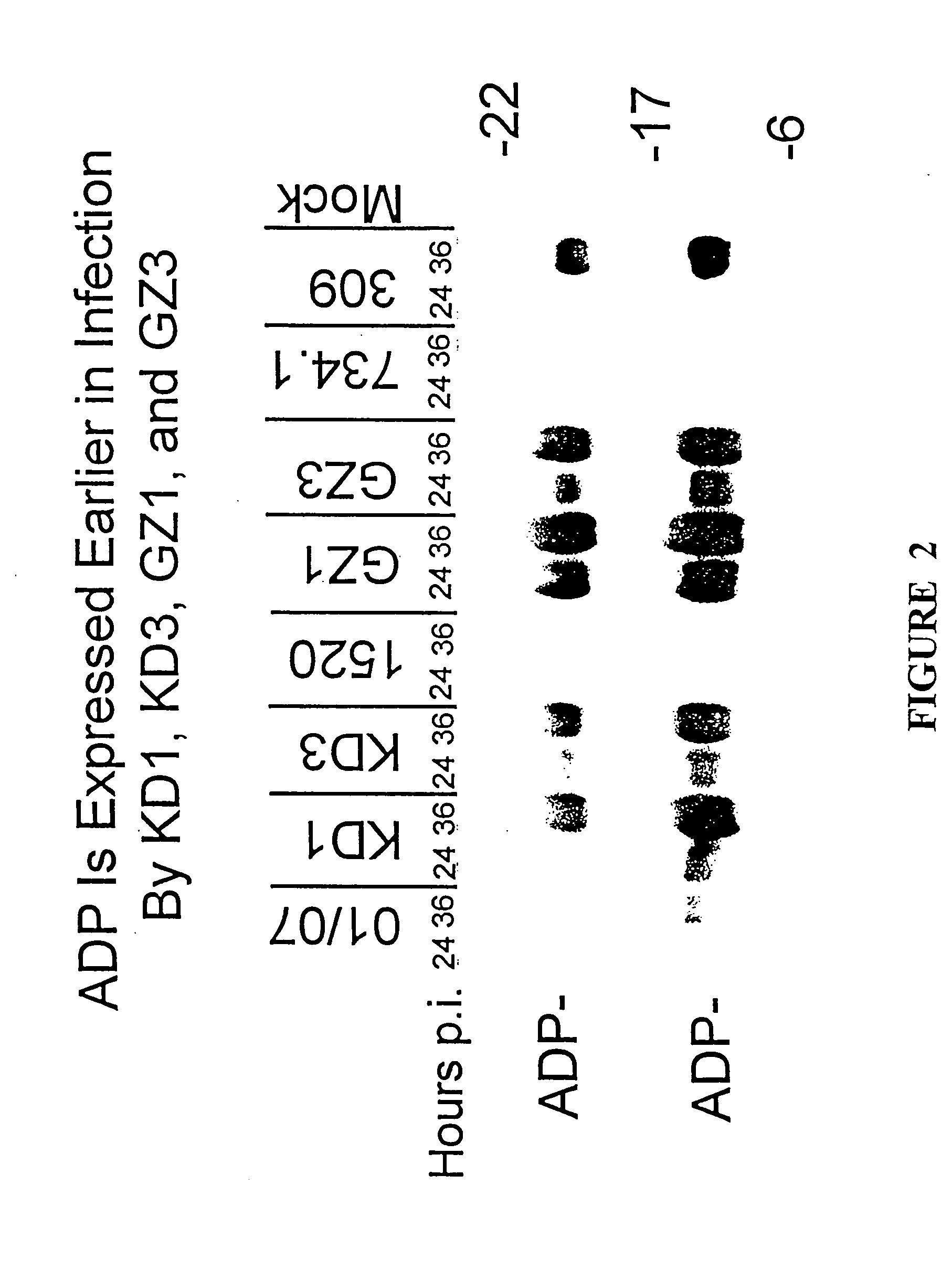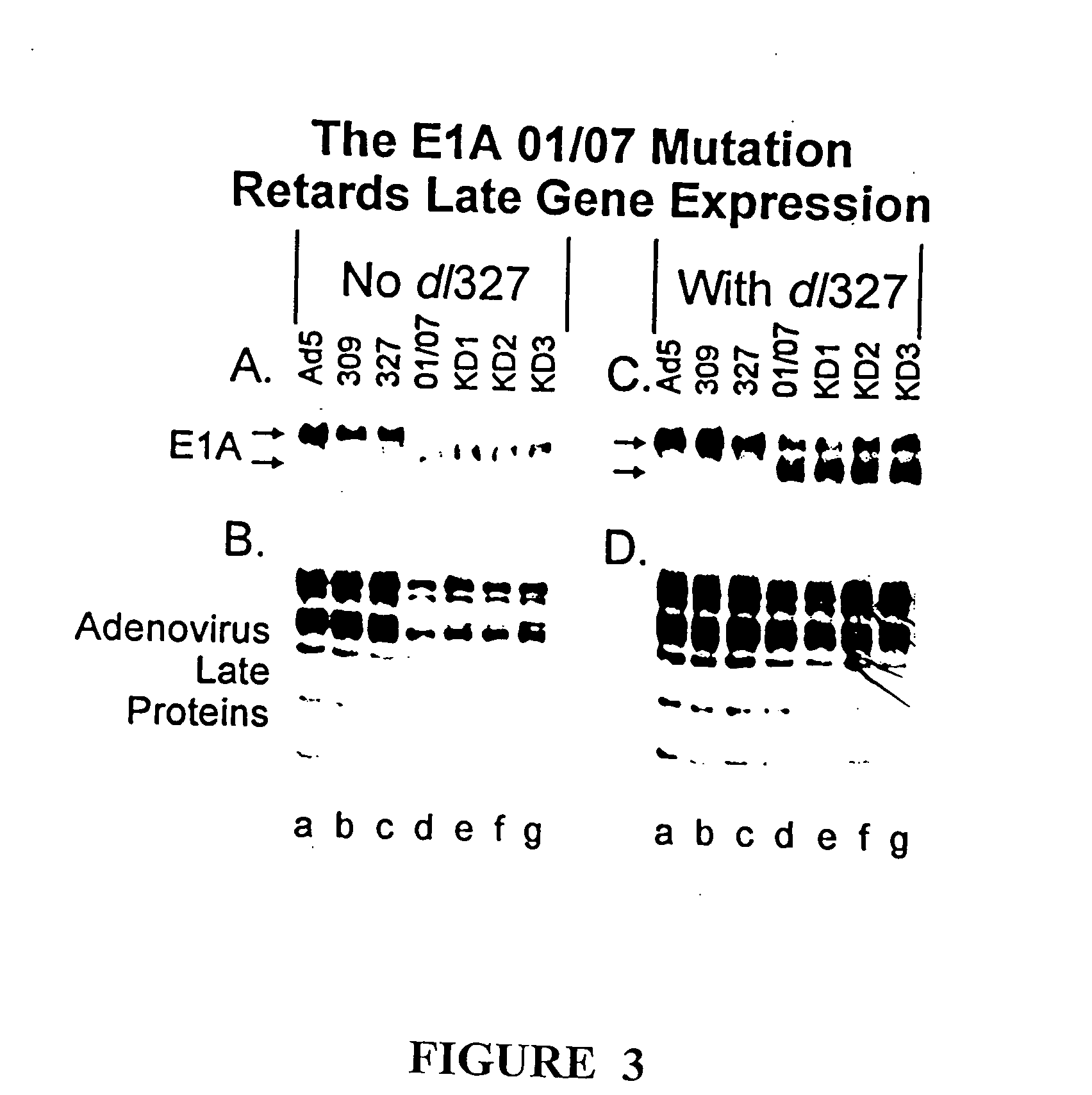Replication-competent anti-cancer vectors
a vector and replication-competent technology, applied in the field of cancer treatment, can solve the problems of inability to replicate vectors, often fail to remove all, and inability to remove all
- Summary
- Abstract
- Description
- Claims
- Application Information
AI Technical Summary
Benefits of technology
Problems solved by technology
Method used
Image
Examples
example 1
[0082] This example illustrates the construction and characterization of the KD1 and KD3 anti-cancer vectors.
[0083] To construct KD1, the inventors deleted the entire E3 region of a unique plasmid, leaving behind only a unique PacI site for cloning. The starting plasmid was pCRII, purchased from Invitrogen, containing the Ad5 BamHIA fragment having a deletion of all the E3 genes; the E3 deletion is identical to that for KD1 and GZ3, the sequences of which are given in SEQ ID NO:1 and SEQ ID NO:4, respectively. The ADP gene from Ad5 was cloned into the PacI site, then built into the E3 region of the genome of the Ad5 E1A mutant named dl01 / 07. This was done by co-transfecting into human embryonic kidney 293 cells the aforementioned BamHIA fragment containing the ADP gene together with the overlapping EcoRIA restriction fragment obtained from dl01 / 07. Complete viral genomes are formed within the cell by overlap recombination between the Ad sequences in the BamHIA fragment in the plasm...
example 2
[0088] This example illustrates that KD1 and KD3 lyse cells more rapidly and spread from cell-to cell faster than other adenoviruses.
[0089] The ability of KD1 and KD3 to lyse cells was examined by a trypan blue exclusion cell viability assay which was performed essentially as described by Tollefson et al., J. Virol. 70:2296-2306, 1996. In brief, A549 cells were mock-infected or infected with 20 PFU / cell of KD1, KD3, dl01 / 07, dl327 or dl309. At various days p.i., the number of viable cells was determined using a hemacytometer (600 to 1000 cells were counted per time point) and the results are shown in FIG. 4.
[0090] Only 25% of the KD1-infected cells and 9% of the KD3-infected cells were alive at 5 days p.i. as compared to 44% of cells infected with dl01 / 07, which has the same E1A mutation as KD1 and KD3. The KD1 and KD3 vectors also lysed cells faster than dl309, which has a wild-type E1A region. When infected with dl327 (ADP−, E1A+), 94% of the cells were alive after 5 days. When ...
example 3
[0095] This example illustrates that KD1 and KD3 replicate poorly in non-growing non-cancerous cells. The replication phenotype of KD1 and KD3 was evaluated using “normal” HEL-299 human fibroblast cells, either growing in 10% serum or rendered quiescent using 0.1% serum. All Ads should replicate well in growing cells, but viruses with the dl01 / 07 E1A mutation should do poorly in quiescent cells because E1A is required to drive them out of G0. dl309, which has wild-type E1A, should replicate well in both growing and growth-arrested cells.
[0096] Cells were infected with 100 PFU / cell of KD1, KD3, dl01 / 07, or dl309. At different days p.i., virus was extracted and titered. In 10% serum, KD1, KD3, and dl01 / 07 replicated well, reaching titers of 10−6-107 PFU / ml, only slightly less than dl309 (FIG. 6). However, in quiescent cells, replication of KD1, KD3, and dl01 / 07 was 1.5-2 logs lower than in growing cells, ranging from 104 to 2×105 PFU / ml. The titer of dl309 reached 107 PFU / ml, nearly ...
PUM
| Property | Measurement | Unit |
|---|---|---|
| surface | aaaaa | aaaaa |
| size | aaaaa | aaaaa |
| structure- | aaaaa | aaaaa |
Abstract
Description
Claims
Application Information
 Login to View More
Login to View More - R&D
- Intellectual Property
- Life Sciences
- Materials
- Tech Scout
- Unparalleled Data Quality
- Higher Quality Content
- 60% Fewer Hallucinations
Browse by: Latest US Patents, China's latest patents, Technical Efficacy Thesaurus, Application Domain, Technology Topic, Popular Technical Reports.
© 2025 PatSnap. All rights reserved.Legal|Privacy policy|Modern Slavery Act Transparency Statement|Sitemap|About US| Contact US: help@patsnap.com



